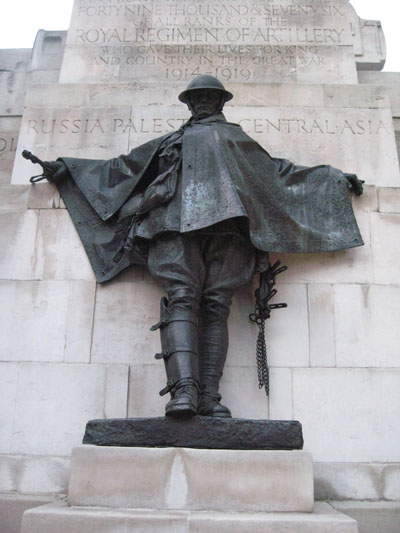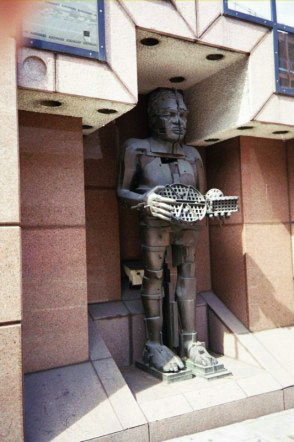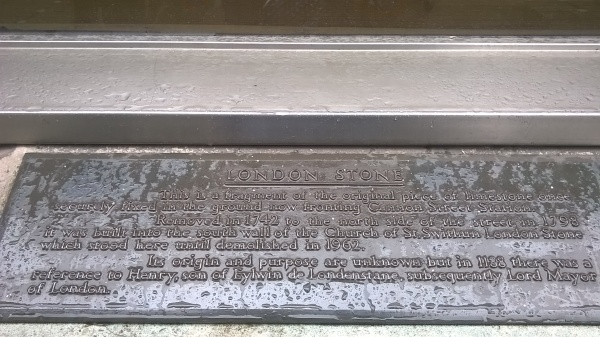Joyful things for Friday – the perambulating London Stone
First up – British (potential) leaders may have been revealed to be treacherous liars without a plan between them, they may have set up a parcel of trouble for the EU with the Front National and the Dutch Party for Freedom agitating to join in leaving (oh thank you so much Brexit for allying us with a bunch of far right horrors that I will not add links to) and it may all be a chaotic pile of pants* here, but, but, but on this day 100 years ago the Battle of the Somme began. Perspective is a wonderful thing:

New Zealand army chief, Maj Gen Peter Kelly, is seen walking among gravestones at the Thiepval. Photo from http://www.bbc.co.uk/news/in-pictures-36680052
So, let us be joyful that no matter how stupid the British have been, we haven’t actually declared war on Europe.
Second reason to be cheerful – you are not as dozy as me. Fact.
On Tuesday, having spent a lovely peaceful afternoon with friends, trees and cake I impulsively decided to visit the London Stone. I hopped on a tube and hot-wheeled it to Cannon Street, slap bang in the City of London. Why? I hear you ask. Well, I’ve been reading Charlie Fletcher’s The Paradox (an excellent book by the way, if you read The Oversight and thought ‘meh’ as I did, then stick with it, I really enjoyed this one and can’t wait for the third) which has been reminding me of his Stoneheart Trilogy (also excellent) and the central role played by statues and the London Stone. I have, in an unstructured fashion, been visiting some of the statues that are mentioned in these books. There’s the war memorial outside Euston,

Image from: https://www.flickr.com/photos/ell-r-brown/4079263592 Copywrite Elliot Brown
The Royal Artillery Memorial on Hyde Park Corner

Image from https://londonhistorians.wordpress.com/tag/royal-artillery-memorial/ Copywrite Mike Paterson
Issac Newton at the British Library

Image from: http://britishlibrary.typepad.co.uk/.a/6a00d8341c464853ef01a511fb4d1b970c-pi Copywrite Rachel Huddart
the Sphinxes by the Thames, various dragons, Samuel Johnson, the Black Friar, the terrifying Minotaur at the Barbican

Image from: http://www.barbicanlifeonline.com/2014/06/24/the-barbican-minotaur-is-back/ Copywrite Dean Nicholas
and the equally scary Grid Man from High Holborn

Image from: http://www.literarylondon.org/london-journal/september2011/wood.html Copywrite Andelys Wood
If you’re interested Andelys Wood has an excellent article here.
Having visited these sculptures, I thought I should visit the London Stone which also has a pivotal role. In Stoneheart the London Stone is alive and malevolent: “it looked out on the street through a thick lattice of iron bars. Given its antiquity, people who noticed this usually thought that the bars were to protect it from the public. Only a very few —and a very strange few at that —knew that it was precisely the other way round” (Charlie Fletcher Stoneheart 2006: 35). What exactly the London Stone is has a long and confused history – it’s geology is oolitic limestone, so it’s not a local stone, but then to mis-quote Terry Pratchett London is mainly built on London. It was obviously important to Jack Cade, as part of his rebellion he struck the stone with his sword and proclaimed himself Lord Mayor of London and Shakespeare has him sitting on the stone to dispense law in Henry VI pt 2.
There are many other stories about the stone, these include it’s the stone where Excalibur was embedded prior to Arthur coming along, or it’s a blood-soaked druidic altar, or the mark from which distances were measured in Roman London, or a talisman whose continued existence, like the ravens at the Tower of London, keep London safe. What we do know is that the stone has been moved around a fair bit, it was first mentioned in the 12th century as a location and at that point the much larger stone stood on the south side of Candlewick Street opposite the now demolished St Swithin’s Church. It appears on this location on both the Copperplate Map and Agas Map, both dating to the late 16th century and by this point it had become a tourist attraction, the antiquarian John Stow included a description of the stone in his Survey of London. In 1671 the Worshipful Company of Spectacle Makers (one of the City’s Livery Companies) broke up a batch of substandard specs on the ‘remayning parte of London Stone’ suggesting a) this was standard practice with faulty goods and b) the stone was probably damaged in the great fire of London in 1666. There’s a reference to the remains being protected by a stone cupola by 1720
and in 1742, having been deemed a traffic hazard, it was moved to the north side of the street and placed by the door of the newly rebuilt St Swithin’s (Clark 2007)

By artist: T. H. Shepherd; engraver: J. Tingle – original engraving, Public Domain, https://commons.wikimedia.org/w/index.php?curid=25706799
There were two more moves before the stone was left alone for a century, now in the middle of the church’s south wall. In 1869 the London and Middlesex Archaeological Society had the stone encased in an iron grille and an inscription in English and Latin (why?) erected on the wall above. St Swithin’s was badly damaged during the Blitz but the walls, and therefore the stone, survived and remained on show.

Image extracted from page 559 of volume 1 of Old and New London, Illustrated, by Walter Thornbury. Public Domain, https://commons.wikimedia.org/w/index.php?curid=32463347
In 1961 the church was demolished and the stone set into the wall of the building that replaced it at 111 Cannon Street. Until 2016, oh yes, it’s moved again. When I got there on Tuesday there was the sign

the protective grille
But no stone. The building it was attached to is going to be demolished and rebuilt, so the stone was moved to the Museum of London in March. It’s now on display there, has been since May, in the dry, where there’s a cafe, not on a busy street in the pouring rain and bad light. If I’d just looked it up before I set off – research, that’s also a fine thing.
Supposedly, once 111 Cannon Street has been rebuilt the stone will go back there, should you wish to see it go to the Museum of London, it’s a lovely museum, well worth a visit even if the stone’s moved again.
Have a great weekend, I’ll be back with more cheerful news next week.
Julia
*For North American readers that’s pants as in underwear, not pants as in trousers, these distinctions need to be made, a chaotic pile of trousers would be bad but a chaotic pile of undies is far worse.
